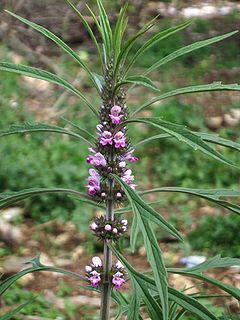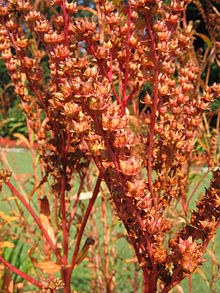
Lonicera japonica, known as Japanese honeysuckle and golden-and-silver honeysuckle, is a species of honeysuckle native to eastern Asia. It is often grown as an ornamental plant, but has become an invasive species in a number of countries. Japanese honeysuckle is used in traditional Chinese medicine.

Pinus thunbergii, also called black pine, Japanese black pine, and Japanese pine, is an East Asian pine native to coastal areas of Japan and South Korea.

Dianthus chinensis, commonly known as rainbow pink or China pink is a species of Dianthus native to northern China, Korea, Mongolia, and southeastern Russia. It is a herbaceous perennial plant growing to 30–50 cm tall.

Ardisia japonica, known as marlberry, is a species of Ardisia native to eastern Asia, in eastern China, Japan and Korea.

Allium chinense is an edible species of Allium, native to China, and cultivated in many other countries. Its close relatives include the onion, shallot, leek, chive, and garlic.

Agastache rugosa, the Korean mint, also known as wrinkled giant hyssop, purple giant hyssop, Indian mint, blue licorice, huo xiang (藿香), and Chinese patchouli, is an aromatic herb in the mint family, native to East Asia.

Leonurus sibiricus, commonly called honeyweed or Siberian motherwort, is an herbaceous plant species native to China, Mongolia, and Siberia. It has verticillaster inflorescence. It is naturalized in many other parts of the world, including South, Central and North Americas.

Eupatorium japonicum, known as fragrant eupatorium in English and 白头婆 bai tou po, in Chinese, is a herbaceous plant species in Asteraceae. It is native to China, Japan and Korea.

Persicaria chinensis, commonly known as creeping smartweed or Chinese knotweed, is a plant species from the family Polygonaceae. It is widespread across China, Japan, the Indian Subcontinent, Indonesia, Malaysia, and Vietnam. It is a common plant in Malaysia and Vietnam, where it is used in herbal remedies, such as for the treatment of dysentery, enteritis, and sore throat. It is a weed in some coastal areas of New South Wales and Queensland in Australia.

Erythronium japonicum, known as Asian fawnlily, is a pink-flowered species trout lily, belonging to the Lily family and native to Japan, Korea, the Russian Far East and northeastern China. It is a spring ephemeral, blooming April–June in woodlands. It is known as zhūyáhuā (猪牙花) in Chinese, eolleji (얼레지) in Korean, and katakuri (片栗) in Japanese.

Angelica dahurica, commonly known as Dahurian angelica, is a wildly grown species of angelica native to Siberia, Russia Far East, Mongolia, Northeastern China, Japan, Korea, and Taiwan. This species tend to grow near river banks, along streams and among rocky shrubs. The root of the plant is widely used for its medicinal properties and is known to contain furanocoumarins and angelicotoxin.
Iris henryi is a beardless rhizomatous iris. It is in the genus Iris, subgenus Limniris and in the series Chinenses of the genus, from China. It has thin green leaves, short stem and light-blue, to creamy-white or pale yellow flowers.
Iris koreana, also known as dwarf woodland Korean iris, is a beardless iris in the genus Iris, in the subgenus Limniris and in the series Chinenses of the genus. It is a rhizomatous herbaceous perennial from Korea.

Iris minutoaurea is a beardless iris in the genus Iris, in the subgenus Limniris and in the series Chinenses of the genus. It is a rhizomatous herbaceous perennial of eastern Asia, native to China and Korea. It has been naturalized in Japan. It has long grassy-like leaves, short stem and bright yellow or pale yellow flowers. It is cultivated as an ornamental plant in temperate regions.
Iris odaesanensis is a beardless iris in the genus Iris, in the subgenus Limniris and in the series Chinenses of the genus. It is a rhizomatous herbaceous perennial from China and eastern Korea. It has blue-green grass-like leaves, short stem, 1 or 2 fragrant, white or off-white flowers in spring to early summer. It is a rare plant in the wild, but it is cultivated in east Asia.

Iris rossii, the long-tail iris, is a beardless iris in the genus Iris, in the subgenus Limniris and in the series Chinenses of the genus. It is a rhizomatous herbaceous perennial from Japan, Korea and China. It has narrow, grass-like leaves, short stems and 1 or 2 purple-violet flowers.

Iris speculatrix is a beardless iris in the genus Iris, in the subgenus Limniris and in the series Chinenses of the genus. It is a rhizomatous herbaceous perennial, from Asia, found in China, Hong Kong and Taiwan. It has dark green, evergreen leaves, long slender stem and flowers in various blue shades, from violet, lilac, lavender, to light blue.

Syringa tomentella is a species in the genus Syringa, in the family Oleaceae.

Acer barbinerve, commonly known as bearded maple, is an Asian species of maple found in Korea, eastern Russia, and northeastern China.

Acer pictum, commonly known as yellow-paint maple, is an Asian species of maple. It widespread across much of China as well as Korea, Japan, Mongolia, and eastern Russia. Its natural habitat is in temperate forests.

















